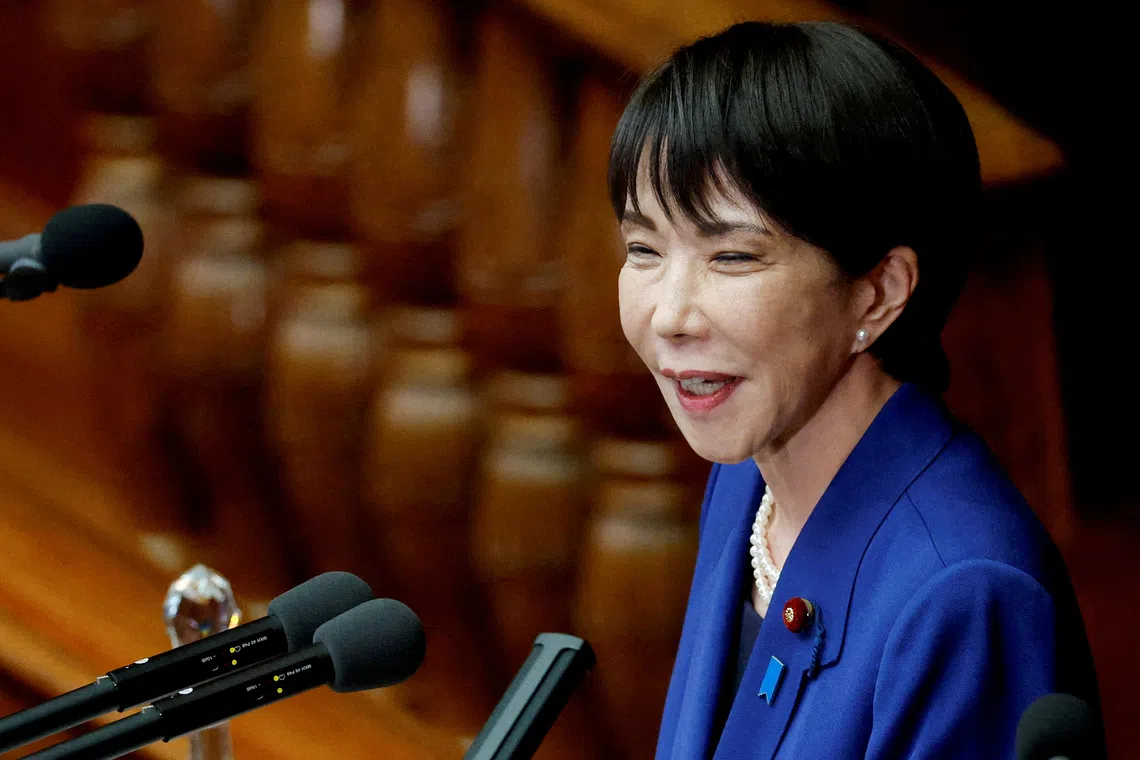Offhand remark, symbolic suit signal long winter for Japan-China ties
Sign up now: Get ST's newsletters delivered to your inbox

Officials said Ms Sanae Takaichi cannot satisfy Beijing's core demand to retract her comment.
PHOTO: REUTERS
Follow topic:
TOKYO - An off-the-cuff remark by new Prime Minister Sanae Takaichi that triggered Japan’s biggest bust-up in years with powerful neighbour China was not meant to signal a new hardline stance.
But after openly stating how Japan might react to a hypothetical Chinese attack on Taiwan, she will struggle to defuse a dispute that could hammer the economy,
China has shown its displeasure with steps designed to inflict pain on the world’s fourth-largest economy after Ms Takaichi’s response, which officials said was unscripted, to an opposition lawmaker’s query in her first parliamentary grilling.
These range from a boycott on travel to a halt on imports of its seafood and cancellations of meetings and cultural events.
But Ms Takaichi cannot satisfy Beijing’s core demand to retract her comment that an attack on Taiwan, the democratically governed island claimed by Beijing, could bring a military response from Tokyo, said the officials, who sought anonymity as the matter is a sensitive one.
“It would have been better not to say it, but it’s not incorrect,” said one of the officials.
“We can’t retract it.”
Opinion polls suggest the comments have not damaged Ms Takaichi’s robust popularity at home, however.
Her “remarks do not change the government’s existing position”, a spokesperson for her office said, adding: “Japan remains open to various forms of dialogue between the two countries.”
China’s Foreign Ministry did not immediately respond to a request for comment.
Long winter ahead
Until now, Japanese leaders had avoided mention of Taiwan in public discussion of such scenarios, hewing to a strategic ambiguity also favoured by Tokyo’s main security ally, the United States.
“Takaichi inadvertently boxed herself in and there really is no immediate off-ramp,” said Mr Jeremy Chan, a senior analyst for North-east Asia with political risk consultancy Eurasia Group.
A former US diplomat who worked in both China and Japan, Mr Chan said there could be a “long winter” in ties between Asia’s top two economies, lasting through Ms Takaichi’s premiership.
Beijing has already ruled out a potential icebreaker meeting between Ms Takaichi and China’s Premier Li Qiang on the sidelines of a meeting of the Group of 20 in South Africa this weekend.
Some analysts liken the rift to one triggered by Tokyo’s 2012 decision to nationalise disputed islands that unleashed mass anti-Japan protests across China. Leaders from both sides did not meet for 2½ years during that dispute.
“If the current downturn in relations drags on as it did then, the economic damage to Japan would be substantial,” said Mr Takahide Kiuchi, executive economist at Nomura Research Institute.
China’s travel boycott alone could cost Japan more than US$14 billion (S$18.3 billion) in losses each year, he estimated.
The bigger fear is that China throttles the supply of critical minerals used in items from electronics to cars, the Japanese government official said.
Despite Japan’s efforts to diversify, China still supplies around 60 per cent of its imports of rare earths, according to macroeconomic research firm Capital Economics.
A broader boycott of Japanese goods in China, as seen in 2012, could lead to a loss in sales equivalent to about 1 per cent of Japan’s gross domestic product and hammer its key automotive industry, said Mr Marcel Thieliant, the firm’s Asia head.
Frosty meet in Beijing
Tokyo’s efforts to tamp down the current tensions have served only to illustrate the deep divide.
Mr Liu Jinsong, a senior Chinese official who received his Japanese counterpart in Beijing on Nov 18, described their talks as “solemn”. Both sides reiterated their grievances, official summaries of the meeting show.
Even Mr Liu’s choice of clothing was a symbol of defiance, state media said. The five-buttoned, collarless style of his suit is associated with an uprising of Chinese students in 1919 against Japanese imperialism that was also a turning point in China’s path to modernity.
Video images broadcast on Chinese television after the meeting showed Mr Liu standing apart from his Japanese counterpart with hands in his pockets, an act typically viewed as disrespectful in formal settings.
“The Chinese obviously do most diplomacy behind closed doors,” said Mr Chan, of Eurasia Group. “They’re masters at it. So the fact that they did this in front of the cameras suggests that they want the whole world to witness this.”
Both Japanese government officials said there was no clear way to try and break the impasse. “Right now, there’s not even a starting point for improvement,” said the second official.
Meanwhile, China is ratcheting up its vitriolic attacks on Ms Takaichi. A Chinese diplomat first appeared to threaten her beheading in a post quickly deleted from social media; a prominent nationalist commentator called her an “evil witch”; and a cartoon on the X account of China’s armed forces depicted her burning Japan’s pacifist Constitution.
“I’m sceptical there is a near-term off-ramp, at least until they (China) fumble relations with Washington again and find the need to try to woo Japan away,” said a senior US diplomat in Asia, speaking on condition of anonymity. REUTERS

